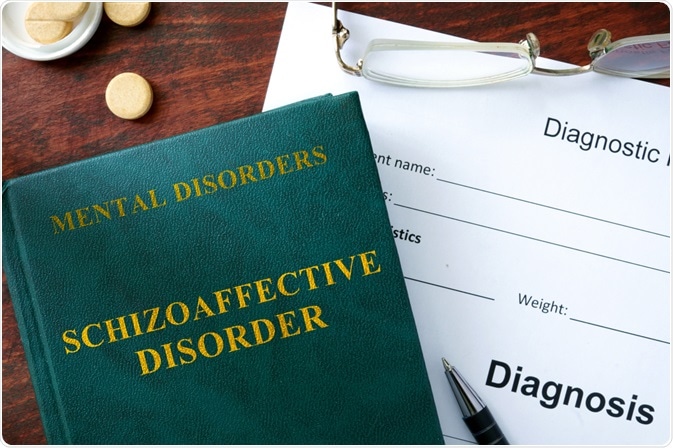What is Schizoaffective Disorder?

Schizoaffective disorder is a combination of schizophrenia and a major mood disorder – such as depression or bipolar disorder. Individuals with schizoaffective disorder experience a combination of alterations in emotions and thinking.
There is a lot of debate amongst psychologists as to whether schizoaffective disorder should be a separate disorder from schizophrenia. Some researchers argue that schizoaffective disorder should be identified solely as a subtype of either schizophrenia or mood disorder.
Treatment and medication for schizoaffective disorder is dependent on what mood disorder symptoms are present, thus tend to overlap with that of mood disorders and schizophrenia.

Image Credit: Vitalii Vodolazskyi/Shutterstock.com
Signs and symptoms of schizoaffective disorder
According to the Diagnostic and Statistical Manual of Mental Disorders, 5th edition (DSM-5) criteria, for a diagnosis of schizoaffective disorder, an individual must experience symptoms of psychosis without the presence of a major mood disorder for more than 2 weeks. Secondly, they must experience an uninterrupted major mood episode with schizophrenia.
These criteria indicate that a bipolar or depressive disorder overlaps the schizophrenia. The diagnosis is dependent on what mood disorder is overlapped – i.e., schizoaffective disorder bipolar type or depressive type.
Individuals with schizoaffective disorder depressive type experience the cognitive and psychotic symptoms of schizophrenia – e.g., paranoia, hallucinations, and dyskinesia – alongside severe depression. Conversely, individuals with bipolar type experience periods of severe mania and severe depression alongside symptoms of schizophrenia.
Schizoaffective disorder as a separate entity is less investigated than schizophrenia and mood disorders. As a result, the cause of schizoaffective disorder is not well known; however, it is thought to be associated with an imbalance in dopaminergic and norepinephrinergic transmission.
Data from twin studies show concordances of around 40%-45% in monozygotic (i.e., identical) twin pairs, compared to 0%-10% in dizygotic (i.e., fraternal) twin pairs for schizoaffective disorder, bipolar disorder, and schizophrenia. This suggests that having a family history of schizophrenia, bipolar disorder, and/or schizoaffective disorder increases one’s risk of developing schizoaffective disorder.
How does schizoaffective disorder differ from pure schizophrenia and mood disorders?
A person with pure schizophrenia is unlikely to experience symptoms of major mood disorders. Individuals with mood disorders experience severe depression or mania (both in the case of bipolar disorder). Severe depression refers to abnormally low mood and mania refers to abnormally elevated mood.
Many individuals with pure schizophrenia may experience periods of agitation and low mood, but this is not akin to severe mania and severe depression seen in mood disorders.
Furthermore, an individual can have both schizophrenia and major depression as a second illness that is not diagnosed as schizoaffective disorder. In this case, the psychotic symptoms from the schizophrenia are much more prevalent than the symptoms of depression. With schizoaffective disorder depressed type, levels of psychotic and depressive symptoms are similar – so for most of the illness, the individual is both psychotic and depressed, experiencing the psychotic symptoms before or after their mood is resolved.
The difference between a diagnosis of schizophrenia with depressive symptoms and schizoaffective disorder is that an individual with the former must not experience symptoms that meet the criteria to constitute a major mood disorder.
Individuals with bipolar disorder experience separate episodes of mania and depression. In between these episodes, there are very few to no symptoms of mania/depression. On the other hand, individuals with schizoaffective disorder bipolar type experience psychotic symptoms in between episodes of mania or depression.
Should schizoaffective disorder be separated from schizophrenia?
Individuals with schizoaffective disorder demonstrate behavior more in line with the schizophrenia spectrum than the mood spectrum. Additionally, neuroimaging, neurodevelopmental and cognitive studies show that the location of schizoaffective disorder is closer to the schizophrenic pole than the mood pole.
These details contribute to the debate as to whether schizoaffective disorder should be considered a subtype of schizophrenia instead of a separate disorder.
Treatment and medication for schizoaffective disorder
As it stands, there is only one Food and Drug Administration (FDA) approved antipsychotic drug for the treatment of schizoaffective disorder specifically, named Paliperidone. Other antipsychotic medications can be used to manage psychotic symptoms of schizophrenia in schizoaffective disorder, such as chlorpromazine.
For the mood disorder symptoms, individuals have prescribed medication depending on which mood disorder is present. With depressive type, they will most likely be prescribed an antidepressant, such as fluoxetine. With mania, they are likely to be prescribed antipsychotics and mood stabilizers, such as lithium.
Conclusion
As it stands, schizoaffective disorder is its own mental health disorder separate from schizophrenia, classified by the DSM-5 as a combination of schizophrenia and a mood disorder.
Despite this, some psychologists suggest that schizoaffective disorder should be classified as a subtype of schizophrenia. This is due to the similarities in the clinical presentations of both schizoaffective disorder and schizophrenia, which are not shared between schizoaffective disorder and depression/bipolar disorder.
Research demonstrates the minor differences in symptoms experienced by individuals with a mood disorder and schizoaffective disorder and schizophrenia and schizoaffective disorder. These differences mean that treatment options are also different in individuals with these disorders, although there exists some overlap.
As for the cause of schizoaffective disorder, research suggests that there may be a genetic influence on whether an individual will develop schizoaffective disorder. There are yet to be any genes identified.
Further research into the genetic nature of schizoaffective disorder is needed to make conclusions and provide insight into more treatment options for schizoaffective disorder directly.
References:
- Azorin, J-M., Kaladjian, A., & Fakra, E. (2005). [Current issues on schizoaffective disorder]. L’Encephale, 31(3), 359–365. https://doi.org/10.1016/s0013-7006(05)82401-7
- Cardno, A. G., & Owen, M. J. (2014). Genetic Relationships Between Schizophrenia, Bipolar Disorder, and Schizoaffective Disorder. Schizophrenia Bulletin, 40(3), 504–515. https://doi.org/10.1093/schbul/sbu016
- Dr. Tracey Marks. (2019). What is Schizoaffective Disorder- Is It Worse Than Bipolar Disorder? In YouTube. https://www.youtube.com/watch?v=jc4R8lWTl8Y
- Evans, J. D., Heaton, R. K., Paulsen, J. S., McAdams, L. A., & Jeste, D. V. (1999). Schizoaffective Disorder: A Form of Schizophrenia or Affective Disorder? The Journal of Clinical Psychiatry, 60(12). https://www.psychiatrist.com/jcp/schizophrenia/schizoaffective-disorder-form-schizophrenia-affective/
- Malaspina, D., Owen, M. J., Heckers, S., Tandon, R., Bustillo, J., Schultz, S., Barch, D. M., Gaebel, W., Gur, R. E., Tsuang, M., Van Os, J., & Carpenter, W. (2013). Schizoaffective Disorder in the DSM-5. Schizophrenia Research, 150(1), 21–25. https://doi.org/10.1016/j.schres.2013.04.026
- Pagel, T., Baldessarini, R. J., Franklin, J., & Baethge, C. (2013). Characteristics of patients diagnosed with schizoaffective disorder compared with schizophrenia and bipolar disorder. Bipolar Disorders, 15(3), 229–239. https://doi.org/10.1111/bdi.12057
- Wilson, J. E., Nian, H., & Heckers, S. (2013). The schizoaffective disorder diagnosis: a conundrum in the clinical setting. European Archives of Psychiatry and Clinical Neuroscience, 264(1), 29–34. https://doi.org/10.1007/s00406-013-0410-7
Further Reading
- All Mental Health Content
- World mental health support and the effect of stigma and discrimination
- A Guide to Coping with Change
- Managing and Reducing Stress
- Analyzing the Stigma Surrounding Mental Health
Last Updated: Nov 17, 2021

Written by
Joelle Hanson-Baiden
Joelle completed her Bachelor of Science degree in Cognitive Neuroscience and Psychology at The University of Manchester in 2021. Prior to this, Joelle completed a Biosciences Foundation Year at The University of Manchester in 2018.
Source: Read Full Article